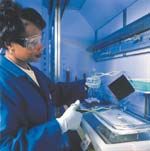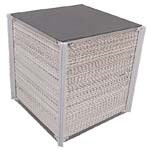New Specialty Polymers Improve Fuel-Cell Economics
Recently formed alliances of fuel-cell start-up companies and engineering-polymer suppliers are already bearing fruit. Their research is coming up with new ion-conducting plastic films for use in Proton Exchange Membrane (PEM) fuel cells. These novel membranes are said to generate electric current more easily, operate across a broader temperature range, and cost less than the incumbent materials, which are mainly sulfonated fluoropolymers.
Interest in fuel cells is high due to their potential as a renewable energy source for cars, homes, commercial buildings, and battery-powered devices like cell phones. Membranes are the heart of a PEM fuel cell, serving as the electrolyte to allow ion exchange and create current. The best-known and most widely used membrane material today is Nafion, a polyperfluorosulfonic acid product that is cast into film and supplied by DuPont Fluoroproducts, Wilmington, Del. Since the 1960s, Nafion has been the membrane of choice in specialized fuel-cell applications such as spacecraft, although Japan's Asahi Chemical and others have more recently imported comparable membranes into the U.S.
Now, a mass market for PEM fuel cells is emerging, sparking interest in lower-cost membranes. Early commercial versions of PEM cells have begun to show up in the past year in portable and emergency power units. For example, Ballard Power Systems in Burnaby, B.C., is field-testing a 250-kw stationary system for factories and a 1.2-kw system to replace small internal-combustion engines in hand-held appliances.
Several new partnerships reflect the intensified effort to develop new membranes:
- Dais-Analytic, Odessa, Fla., is teaming with Dow Plastics, Midland, Mich., to commercialize a lower-cost membrane based on Dow's Index ethylene-styrene interpolymer (ESI).
- Celanese Ventures GmbH, Frankfurt, Germany, is developing a polybenzimidazole (PBI)-based membrane for fuel cells that operate at relatively high (150 C) temperatures.
- Cell maker Ballard is working with the British parent of Victrex USA, Greenville, S.C., to produce two new membrane alternatives. One is based on sulfonated polyaryletherketone (a variant of PEEK) resin supplied by Victrex.
Thinner, cheaper options
DuPont's Nafion is 5 mils thick and works at high humidity and 60 to 80 C. Industry sources say it typically sells at about $600/m2, although that varies widely depending on use and customer.
The nascent fuel-cell industry is shifting to thinner membranes, notes Richard Okine, technology manager at the newly formed DuPont Fuel Cells Business. A thinner membrane translates into higher current density, which in turn means enhanced generating power. The trade-off is a less mechanically robust membrane.
DuPont has responded by coming out with a 2-mil-thick Nafion film, which is finding growing use, and is working on a 1-mil version. DuPont also hopes to be ready in about two years with a membrane that would operate at higher temperature, which increases generating efficiency.
Okine does not believe that high membrane costs are holding back fuel-cell commercialization. "We are working to get Nafion's cost down as the market expands," he says. DuPont's goal is to keep Nafion at the same relative cost level—i.e., about 5% of the total cost of a cell.
Dais-Analytic CEO Timothy Tangredi says his firm's technology dramatically reduces membrane cost, opening potential in both fuel cells and moisture-transfer membrane applications for heating and air-conditioning systems. The company uses Dow's ESI as the basis of its membrane. Dais accomplishes partial (30-60%) sulfonation of the cast film using its own patented process. Other film-making methods such as blown film are being investigated.
Tangredi says the sulfonated ESI membrane costs less than Nafion, has excellent ion conductivity and water uptake, and can be tailored for specific end uses. It has two potential limitations: a relatively low (85 C) operating-temperature limit and possibly a shorter membrane lifetime. Tangredi says Dais has developed methods to ensure the ESI membrane stays mechanically and chemically robust.
Dais sees ESI membranes being used within a year in portable power cells and within two years for stationary power generation. Another developing application is in conditioning air streams to promote stable fuel-cell operation. An immediate goal is to create an entirely new market for ion-conducting ESI membranes in moisture transfer applications (see box).
Tiered market emerges
The embryonic membrane market calls for a range of cost-performance and leaves room for numerous options, says Charles Stone, advanced materials v.p. at Ballard, which is partnering with Victrex to supply two alternatives for this market. One is Ballard's BAM ionomer, a partially fluorinated membrane with hydrocarbon pendant groups, which is said to cost less than Nafion. Even less expensive is a sulfonated variant of Victrex PEEK, a high-temperature resin.
Ballard and Victrex envision a four-year program during which Victrex would build pilot plants for up to 100,000 lb/yr of each membrane polymer. That much material would cast enough film to make 100,000 automotive fuel cells. Both materials promise good mechanical properties, reduced oxidation, and potential for higher-temperature performance if that need emerges. Above all, once pilot plants are brought on-line, resin cost would be significantly lower than for sulfonated fluoropolymers.
Meanwhile, Celanese Ventures has its sights on meeting anticipated demand for membranes usable in higher temperature fuel cells, which are said to be more energy efficient than today's cells that operate at under 100 C. The company's PBI polymer can operate at the expected 150 C requirement, or even at 190 C. Celanese already makes PBI materials at a plant in the U.S. for use in textiles for fire-protection garments.
Celanese Ventures, along with its partners—Honda in automotive fuel cells and Plug Power of Latham, N.Y., in residential power cells—plans to build a manufacturing plant for Membrane Electrode Assemblies (MEAs) using PBI membrane by mid-2002. Carsten Henschel, a spokesman for Celanese, says a PBI membrane is more tolerant of carbon monoxide (which can poison the membrane) and makes gas cleaning less costly. Heat management is also less complex and costly with high-temperature-resistant PBI.
Related Content
The Importance of Barrel Heat and Melt Temperature
Barrel temperature may impact melting in the case of very small extruders running very slowly. Otherwise, melting is mainly the result of shear heating of the polymer.
Read MoreHow to Select the Right Cooling Stack for Sheet
First, remember there is no universal cooling-roll stack. And be sure to take into account the specific heat of the polymer you are processing.
Read MoreMedical Tubing: Use Simulation to Troubleshoot, Optimize Processing & Dies
Extrusion simulations can be useful in anticipating issues and running “what-if” scenarios to size extruders and design dies for extrusion projects. It should be used at early stages of any project to avoid trial and error and remaking tooling.
Read MorePart 2 Medical Tubing: Use Simulation to Troubleshoot, Optimize Processing & Dies
Simulation can determine whether a die has regions of low shear rate and shear stress on the metal surface where the polymer would ultimately degrade, and can help processors design dies better suited for their projects.
Read MoreRead Next
See Recyclers Close the Loop on Trade Show Production Scrap at NPE2024
A collaboration between show organizer PLASTICS, recycler CPR and size reduction experts WEIMA and Conair recovered and recycled all production scrap at NPE2024.
Read MoreLead the Conversation, Change the Conversation
Coverage of single-use plastics can be both misleading and demoralizing. Here are 10 tips for changing the perception of the plastics industry at your company and in your community.
Read MoreMaking the Circular Economy a Reality
Driven by brand owner demands and new worldwide legislation, the entire supply chain is working toward the shift to circularity, with some evidence the circular economy has already begun.
Read More























